White is an odd beast in cube. It is the colour of removal and has pretty much the best tools for dealing with the various card types. Jund colours are a little better and spot removing lands and black has more planeswalker removal but white can do it all and does the other types the best. It has some of the most playable cards that can hit any (non-land) permanent and the most efficient single type and Disenchant flavoured removal. White also has all the best mass removal on the whole as well. White may seem abundant in good removal however that is just because it covers such a broad range. When you are after a specific kind of removal white typically gets quite thin quite quickly. Black has Terror effects for days while white will hit the bottom of the barrel pretty fast.
In this list I am going to take a look at the one mana creature removal options in white. It is somewhat of a follow up to the look I had at black one mana removal. While the top of this list blows the black cards out of the water the average power of these cards is probably below that of the black cards. White's removal is also a bit all over the place. It is a lot more contextually narrow than the more generic black cards. A white removal spell might be good in a control deck but terrible in an aggressive deck. This makes it much harder to appropriately pad out white with good removal options.
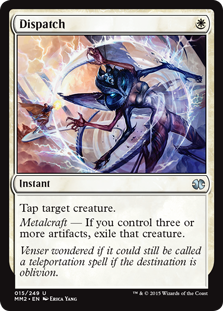
White has two archetypes in which it is a main colour, one of which is control and the other aggro. Both deck types want cheap spot removal. Aggressive decks want to be able to clear away blockers so as to freely attack and they want to do it cheaply so that they can continue to mount up the pressure. Control decks want to be able to slow down the game by handling early aggressive plays that might do critical damage prior to mass removal, they want to be able to do multiple things in a turn and they want to be able to snipe out tenacious creatures that might survive a mass removal spell. The first two mostly just require low cost, the latter often requires exile and instant. On the flip side, control decks don't often care about dealing with utility creatures that don't attack as the mass removal will get them and they are typically less urgent threats to deal with. White has good removal options for stopping things when attacking. The main problem for the aggressive decks is dealing with those utility dorks as aggressive decks do not have mass removal to handle them like control does. The removal desired by the aggressive white player puts far more of a premium on things are are not restricted to effecting creatures in combat.
The issue for cubes is that the best card for an archetype is not always the best card for the cube. In modern Terminate is one of the best removal spells and it gets a lot of play, or certainly did before Fatal Push. In cube Terminate is only marginally more effective than a Go for the Throat. It is also less broad in range than Dreadbore. I don't run Terminate in my cube because it isn't offering that much more than the alternatives while being that much narrower. Terminate is better than Go for the Throat but it has well under half the playability. Cube cards have to take into account playability as well as suitability to purpose. Yes, a specific card might be the best option for an archetype but if it isn't playable in anything else it probably isn't going to improve the way your cube drafts and plays by including it. That design philosophy makes it rather awkward adding in cheap removal to white. Either you are using low powered cards that cater to every one or you are using narrow cards.

I ruled out a number of cards like Murderous Cut from my black one drop removal options as it is not a turn one removal card. Much of the value of being one mana is that you can start interacting right away. The need of doing stuff immediately is increasing as power creep continues to push tempo and more cheap answers are needed for the slower decks to stay in the game. There are a bunch of somewhat one mana white removal options that I am also ruling out for this list for their inability to do much on turn one. Dispatch can work on turn one as you only really play it in affinity which is more than capable of metalcraft out of the gates. However you look at it the card is suitably narrow that despite being the best removal spell in the game when you fulfill the conditions you can't include the card in many cubes at all. Next up on the honourable mentions is Soul Snare. A fairly cheap and fairly effective defensive removal card that has some nice synergies from being an enchantment and a permanent. A decent control card but a fairly useless aggressive one. Sadly this has been left off this list because it is a two mana removal spell and not because it is too narrow. Plenty narrower cards to be found high up on this list! Lastly we have Gaze of Justice. Similar looking to Dispatch but a brutal additional cost. Tapping three guys is only something you can do in an aggressive deck and tapping three guys is such a huge loss of tempo it rather defeats the point. Narrow, situational and often counter productive! Also near impossible to use on turn one but bad enough that that isn't the problem for the card.
So, on to the list of options. Be prepared for some weak cards! So as to compare to the black options I will also give these cards an out of ten rating as well as their rank in the list. There are even some weaker ones I didn't include. Mostly direct downgrades on cards already here.
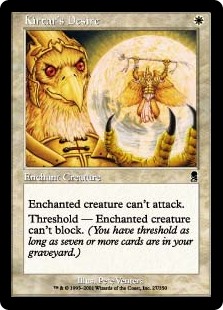
13. Kirtar's Desire (0/10)
This is a bad Pacifism and Pacifism is pretty bad. In a defensive situation this is better than Pacifism a lot of the time but that doesn't stop it from being a bad effect overall. This is totally unplayable in an aggressive deck as you won't have threshold until the super late game, usually not at all. Pacifism itself is bad because it is fairly easy to remove and does nothing to stop abilities and static effects. Just because you put a Pacifism on a Creeperhulk doesn't mean you are surviving. Other reasons Pacifism effects suck are that you can also still sac off the creature for value, bounce and recast it free from its aura, give it protection such that the aura falls off, or simply kill the Pacifism and have a potentially flash haste version of your guy back. Risky and narrow card. So yes, this card is better than Pacifism in control decks but you still don't want it.
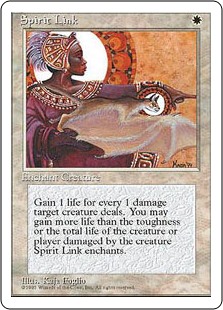
12. Spirit Link (0.5/10)
Back in the day, like the "old school" days way before cube, before even the internet was really a thing, this card was quite a viable way of shutting down a dork. Most dorks were just fairly vanilla beaters. I have seen many a game won with a forest walking Llanowar Elf skipping past a bunch of Spirit Linked Ernham Djinns! The only real removal then was Wrath of God and Swords to Plowshares so the Link was a decent way of stalling things till you found a Wrath. That stopped being a thing pretty quickly as dorks first phased out for super powerful spells, then slowly phased back in, first with lots of utility and EtB effects and more recently with massive amouts of stats, keywords, activated, triggered and static abilities too! Spirit Linking most dorks in the cube is doing little useful at all. It is pretty much a Kirtar's desire in that it will stop something attacking effectively. The sole reason I have rated it higher is that it can be a pretty good answer to some of the red hate bears and pingers. Put it on an Eidolon of the Great Revel and you are happy with things, likely they will have to kill their own guy or play nothing cheap for the rest of the game! Spirit Link also has the dual utility of being able to buff one of your own dorks. Not great but lifegain is a good counter to burn decks. It isn't a good enough sideboard card against red considering the alternatives to be worthwhile there and it isn't good enough against the whole field to ever play main really. All it is is better than Kirtar's Desire!
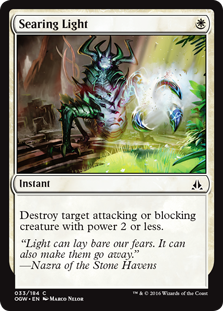
10. Righteous Blow 2.5/10
11. Searing Light 2/10
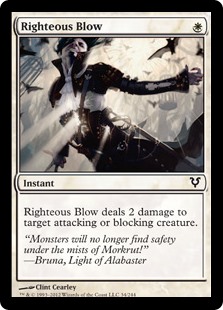
Basically these are the same card. Blow is slightly better in control decks and Light slightly better for the aggressive decks. High power low toughness things are generally higher priority to kill as a control player. Blow will kill a Bloodbraid, Thalia Heretic Cathar, Ahn Crop Crasher etc. Light on the other hand tackles defensive dorks like Courser of Kruphix and Wall of Omens more effectively. The damage from Blow is something you can abuse or combine with first strike or normal creature damage respectively as well giving it slightly better ability to take out big things. That said their are more expensive creatures with low power in the cube and the average toughness is higher than the average power. In theory Light should have a higher ceiling and a greater range of targets. On the whole these are not great cards for aggressive decks as you have to incur a block. The real cost for playing these as an aggressive player is higher than one mana, more likely two or three damage that you don't get to do as well. Neither is able to handle a utility creature outside of combat either. Righteous Blow makes Disfigure look really really good and Disfigure makes Shock look pretty impressive and Shock doesn't make the cut in red. These cards would be pretty embarrassing to have to resort to using. They are suitable for doing the desired role but they are incredibly low powered.
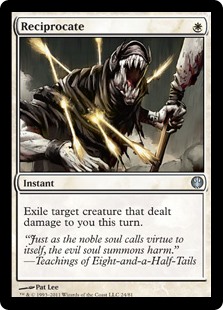
9. Reciprocate 3/10
While this is instant and exile (the holy grail of removal!) and concedes nothing to the opponent it is rather a ball ache to use. Generally it fails it killing everything that isn't attacking. That makes it pretty useless in aggressive decks and inept again at handling utility dorks. Every now and against you get to kill a Chandra or Thermo-Alchemist or other red pingy thing but that isn't very exciting. On top of a deceptively low target range and narrow control only use this card requires you to take a punch. Control players don't like taking punches. The card also scales up impressively badly for a card with no size, colour, or shape restrictions. You want to kill that Blightsteel Colossus? You have to take some damage from it, better not take it all! This is a terrible answer to almost all the fatties bar an Inferno Titan that happens to do some face damage. This card is really quite bad, much worse than it looks. If you are willing to put cards this narrow into your cube you can do a whole lot better in the power and effectiveness.

8. Chained to the Rocks 4/10
Presently with just lands you can get a maximum of 9 cards that will allow you to play this turn one (seven sac lands, Plateau and Sacred Foundry) in a singleton cube. Realistically it will be more like half that at best. This is less consistent turn one than most of the cards on this list. It is also narrower as you have to be in red or have great fixing for some splashed in duals. After jumping through all those hoops you get a Journey to Nowhere at a one mana reduction! Journey is OK but it is risky and on the clunky side. It has many of the drawbacks of Pacifism and some extra ones too! The mana reduction here doesn't solve the clunkyness of this style of card. Best case scenario this is a one mana exile that hits any target. Worst case scenario it sits dead in hand for a while and then only results in flickering a creature that has a strong EtB effect. If you Chain a Titan to the Rocks and they kill the Chains or the Rocks at the end of turn then you are in trouble! This is a high risk card, it is a very narrow card too. The payoff is decent but in cube I cannot advocate running this over Journey even if you are trying to up the one drop removal options.
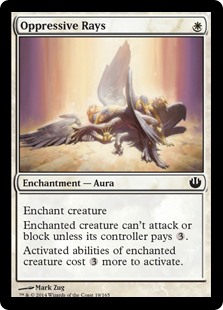
7. Oppressive Rays 5/10
Here we have an unsuspecting winner. This does what so many white cards fail to do in that it shuts down most things that want to remain out of combat. This would even do a good deal to tame a Creeperhulk. They would need 8 mana to pump something else and attack/block with both which would pretty heavily shut things down. More importantly this takes a huge dump on a card like Birds of Paradise or Thermo-Alchemist. In many ways this is the white Paralyze. It is a tiny bit worse in that it is 3 mana to do the thing not 4 but you only need to pay the 4 once if you want to block with your Paralyzed thing and you don't need to pay anything at all if it has an ability you don't need to tap to use. Given that white lacks the ability to hit the utility dorks with so much of its removal I think Oppressive Rays has a lot more value in white than Paralyze does in black. Yes, this has all the same risks as other enchantment and aura based removal in that it isn't very permanent however that is generally less of a concern with the utility creatures. If they get their Llanowar Elf back at instant speed on turn five thanks to a Naturalize you are unlikely to care very much. This is basically an Arrest for the early game and likely much of the midgame too. It works well in control buying time until mass removal and it works well in aggressive decks proactively taking out any creature they like in a very cost effective way. This will be the next white one mana removal spell I will add to my cube if pushed to do so. This is lower risk than most other enchantment based removal while seemingly being very effective for the mana. Yes, this has fairly poor scaling, most people will be happy to pay 3 to smack you with a Titan. White already has good removal for handling the big stuff, it is dealing with the little things that white is most eager to expand on and Oppressive Rays gets that job done well.
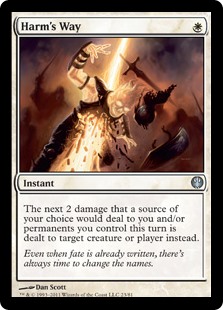
6. Harm's Way 6/10
At first I thought this would have to be in the honourable mention section as it isn't a true removal spell that you can reliably use on turn one. The thing is that this list is full of cards like Reciprocate and Righteous Blow which are just as hard to have active as Harm's Way. Any one mana removal that relies on targetting things in combat can only be used on turn one when on the play if facing off against a hasting one drop like Goblin Guide. On the draw they can at least hit any one drop attacker or two drop with haste. As such Harm's Way is eligible for this list. Harm's Way looks to be a pretty direct upgrade to Righteous Blow. Unless they are attacking with a 1/2 it will kill Shock something and you will take two damage less than if you were using Reciprocate. It also has way more combat trickery and interaction with Burn making it a far better card all round. Provided they have some dorks involved in combat it can be used to take out the non-combat utility dorks as well. This is part removal, part combat trick and part Deflection (for burn spells). It is mildly situational but this is more than made up for by its wide range of utility. While not always as good and reliable as a Shock it does have a higher average range which is not something we can often say about one mana removal cards outside of red.

5. Condemn 6.5/10
This is fantastic removal but it is narrow. You can't play this sensibly in an aggressive deck, this is for midrange and control players only. Against attackers it is basically just another Swords to Plowshares. Control players care not about conceding life. Bottom of library is basically as good as exile. It gets round persists and on death triggers and will rarely be seen again. Often by the time a Condemned card is seen again it is actually just a bad draw. If you hit their one drop on turn one then your Condemn is probably better than exiling the card. Comdemn is a great answer to vehicles, man lands and other awkward threats that evade mass removal. Due to the way in which white removal is split I am happy with a couple of removal spells that are narrower in my cube provided they have this level of power.
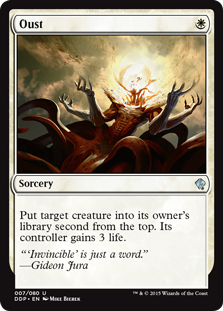
4. Oust 7/10
This is quite an oddball removal spell. For white this is about as middle of the road as you can get. As a sorcery it is a bit more restrictive for control decks and conceding three life is a turn off for the aggressive decks. It is also a lot less permanent removal than Condemn, probably even Oppressive Rays and the like. This makes it even weaker against things with EtB effects. With all that in mind this is a one mana one for one removal spell that will hit any target and get it out of play no fuss for a decent chunk of time. This has much steadier scaling than either of the big names Path or Plow. On turn one 3 life is less of a big deal than a free land regardless of whether you are aggro or control. In the late game 3 life is also less of an issue than the six or more life Swords will be giving up to get rid of that Wurmcoil Engine etc. Oust isn't tricksy or clever. It isn't the perfect removal card for any situation really but it gets the job done in most. It handles beaters and utility dorks, big things and small things. It gives you great control over the game and it comes at a very reasonable price indeed. Oust also has a much more brutal effect than most other removal cards when it hits certain things at specific times. A one or two mana ramp creature made on turns one or two respectively is incredibly powerful and represents a huge tempo play in most cases. Two turns down the line those cards will have lost a significant portion of their value. Sometimes redrawing that elf on turn three will represent a worse draw than an average card from the deck. In such cases you have done better than going 1 for 1. Even more brutally you can really punish people who are stuck on lands draws. The very last time I cast Oust I managed to do it to a Tasigur on a player stuck on three lands. Not only did this deny them the land for a turn extra but it gave them an unplayable card back and wasted a big chunk of their delve reserves. Oust is just so cheap, reliable and rounded and white has so few generic options that it almost always sees play somewhere. It is certainly a card that performs a lot better than you would expect just having read it. If it were instant I think it would be comparable to the other best removal cards in all of magic.
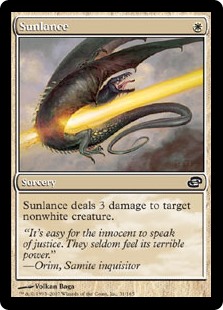
3. Sunlance 7.5/10
The white Flameslash is a lot lot worse on paper. It does one less damage and can't hit white things. In practice red struggles with big creatures and white doesn't. White struggles with cheaply and efficiently handling small stuff in play. Flameslash doesn't add that much over other cheap red burn in red nor does it solve the colours problems. Sunlance on the other land sorts out white very nicely indeed. Compared to Oust it has a far lower range of targets. In my cube Sunlance hits and kills about 60% of creatures. About 25% of those it doesn't hit are because they are white and the remaining 15% or so are non-white dorks with 4 or more toughness. This might seem like a low range but in practice Sunlance kills way more things. Firstly you are white meaning there are less other white players are the table. You can probably on average cut that 25% of white things you miss in half, especially if you are an aggressive white player with lots of the cheap white dorks in your poool. Further more, you are using cards like this to empower your early game. The majority of the 15% of dorks too large to kill with Sunlance are late game cards. They probably average about 5 mana. If it were not for 0/4 and 5 walls it might be closer to 6! In the early game you can expect your Sunlance to be killing most things. Mostly down to not giving up 3 life Sunlance is a better aggro card than Oust. The broader target range and better late game scaling make Oust the better control card but both are good enough that you will play either in either if you just need more removal. Sunlance is also better than Oust against creatures with EtB effects. It also turns out there are just a lot of dorks in cube you just want dead. You might Oust that Dearthrite Shaman now but you know you will want to kill it again in two turns time. No non-red removal on Baleful Strix feels good but Oust feels very bad while at least Sunlance feels OK.
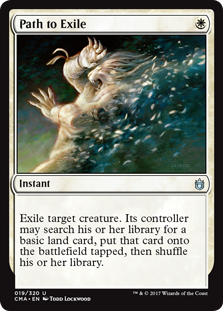
2. Path to Exile 9.5/10
One mana, any target instant speed exile removal. This is like one of those unbeatable top trump cards that just has highest or joint highest stats in every category. My cube also has so many dual lands that this doesn't even give away lands 20% or so of the time it is used in drafts and sealed and even higher percentages in constructed events. Generally this is the premium removal for aggressive decks who don't wish to give up life. Using this too early however is a pretty hefty hill to then climb back up. Path to Exile has the best late game scaling of any spot removal spell and so you want other cheap removal to pair with it so that you might be able to use that over this in the early game. Obviously being one mana still makes this great late game and gives you the option to use on turn one if you need to as well which are all huge perks.
1. Swords to Plowshares 10/10
Like so many of the best cards in magic this little gem hails from Alpha. Unlike many of those best cards this was one of the fairer and better designed ones that saw reprints for longer and far less in the way of restrictions and bannings. Swords is about as good as a card can be before it becomes oppressive or broken. It has all the qualities of Path to Exile and it has a less significant drawback with steadier scaling. While not always better than Path, or even something simple like an Edict, Swords is by far and away the most playable and effective removal spell on average.